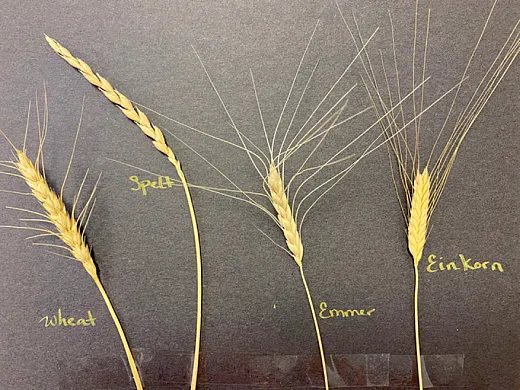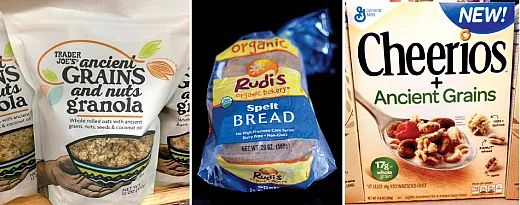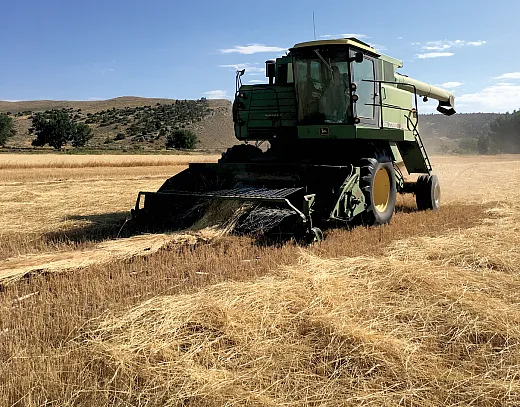Ancient Alternatives
Examining the Benefits, Barriers of Growing Ancient Grains in Wyoming

- Ancient grains can broadly be defined as those that are largely unchanged over the last several hundred years. The market for ancient grains has greatly expanded in recent years, largely driven by consumer interest in health benefits, old flavors, and histories.
- A new report from Crop, Forage & Turfgrass Management examines what ancient wheats grow best in Wyoming and what markets are available for them.
- Overall, the results found that emmer had the highest yield of the three ancient wheats studied and may be best suited for production in Wyoming, and the northern part of the state was best suited for growing ancient wheats.
Despite constant and rapid technological change, the adage “what is old is new again” persists in the food and farming industries. Consumer interest in health benefits, old flavors, and histories—coupled with farmers’ desire to diversify crop rotations and increase profitability—has expanded the markets for ancient and heirloom varieties of fruits, vegetables, and grains in recent years.
Often these products are coming full circle, having once been in vogue only to often lose out to competition powered by modern breeding techniques resulting in higher yield. One such snapshot is on display for ancient grains in Wyoming. In the small town of Worland, Professor B.C. Buffum, the former director of the University of Wyoming Agricultural Experiment Station, was singing the praises of emmer wheat as early as the 1910s. Around 1915, he owned an emmer breakfast food factory, and a 1911 article in The Nationalist Magazine claimed that “improved winter Emmer…is surpassing even the best wheat as a food for civilized man.”
Caitlin Youngquist, Ph.D., an expert on ancient grains in Wyoming, has returned to this history for her own work on emmer and other ancient wheats. She and collaborators have researched what ancient wheats grow best in Wyoming and what markets are available for them.
“Buffum was a plant breeder and very dedicated to emmer and developing new varieties,” she says. “He was adamant it was the food of the future and clearly saw it was performing well in Wyoming. But for some reason, it didn’t last.”
What Are Ancient Grains?

Ancient grains can often defy definition with the botanical meaning usually being narrower than what the average consumer would identify. Broadly, they can be defined as grains that are largely unchanged over the last several hundred years, says Caroline Sluyter, Whole Grains Council program director at Oldways, a nonprofit dedicated to sharing information about ancient ways of eating and healthy diets.
Modern wheat is constantly bred and changed and not considered an ancient grain. Examples of ancient wheat include einkorn (Triticum monococcum L.), emmer (Triticum turgidum L.), and spelt (Triticum spelta L.). Grains like sorghum, teff, millet, quinoa, and amaranth are often considered ancient grains. Data gathered by Oldways also show that ancient grains have much lower levels of recognition than other grains like whole wheat, oats, and rice. Under a broad definition of ancient grains, consumers are much more familiar with wild rice and quinoa compared with something like einkorn, emmer, or spelt.
Ancient wheats are primarily desired by consumers as a health food in the specialty market. Many have higher protein and nutrient levels than modern wheat, and some individuals who cannot eat gluten report being able to eat some ancient wheat varieties. While not as broadly useful for baking as modern wheat, there are specific recipes and methods uniquely suited for the flavor and characteristics of ancient wheats.
The market for ancient grains has greatly expanded in recent years. Between 2010 and 2016, there has been a 269% increase in processed food products labeled as “ancient.” Market forecasts predict that the food market for ancient grains will expand at a rate of more than 35%, reaching $6.3 billion by 2024. Data also show that 20% of shoppers would pay more for a product that contains ancient grains.
A University of Wyoming Extension report by Youngquist and others summarizes the history of einkorn, emmer, and spelt—with einkorn, a diploid with two sets of chromosomes, being one of the first domesticated and grown for food by humans. It was likely a cross with a wild grass that gave rise to the tetraploid emmer, and further crosses gave rise to the hexaploid spelt. New sets of chromosomes gave the crops the ability to adapt to a wider range of conditions.
Testing Performance on Marginal Lands
Youngquist and others are returning to Wyoming’s history with ancient wheats. In a recent article in Crop, Forage & Turfgrass Management (https://doi.org/10.1002/cft2.20237), Youngquist and collaborators published on field trials that tested ancient wheat production on marginal lands in Wyoming. Youngquist was an Extension educator at the time of the study, and additional work was done to have local producers plant the ancient wheats and share their observations.
“The purpose of the larger project, called the Wyoming First Grains Project and funded by Sustainable Agriculture Research and Education (SARE), was to test these grains and also work with producers around the state,” Youngquist explains. “We wanted to learn how to grow ancient grains in the state and develop markets. Many producers are looking for alternatives to malt barley that they grow to make beer. It can be very beneficial to have options in addition to current contracts. Overall we worked at three research stations and with about six producers.”
The research station trials reported in the article studied einkorn, emmer, and spelt under irrigated and rainfed conditions to learn more about spring‐planted ancient wheats. They only tested one variety of each ancient wheat, something Youngquist says can be expanded in the future. Overall, the results found that emmer had the highest yield of the three and may be best suited for production in Wyoming, and the northern part of the state was best suited for growing ancient wheats.
Across the locations, yields (in pounds per acre) averaged 832 for einkorn, 1,492 for emmer, and 1,064 for spelt with protein content ranging from 14.7–15.9%. For comparison, in 2017, spring wheat yield averaged 3,642 and 1,020 lb ac–1, respectively, for irrigated and dryland production. The protein content of modern wheat averages 10.7%.
Revenue Potential
However, due to the specialty market for ancient wheats, higher prices can make up for the lower yield of ancient grains. In addition, past research has shown the ancient wheats can be grown with less inputs, such as water and fertilizer, which can further increase profits. Youngquist notes that while their research station data was inconclusive on the question of inputs, producers they partnered with reported lower water requirements for the ancient wheats compared with their malt barley crops. Youngquist hypothesizes this may be due to larger and longer roots observed in the ancient wheats.
Another potential aspect of ancient wheats is the multiple uses or revenue streams they offer. For example, in Wyoming, there is a market for straw to feed cattle. However, modern wheat and barley has been bred to be shorter and shorter, limiting the usefulness and profitability of straw as a secondary product. The ancient wheats stand much taller and produce high quality straw. This means an additional marketable product for farmers to help offset the lower grain yields, Youngquist says. Another possibility is a forage or cover crop using a method called dual‐purpose winter wheat where wheat is planted in the summer, carefully grazed to get some use without damaging the growth points, and then allowed to overwinter and set seed the next year to be harvested for human consumption.
“The idea is that we begin to think creatively about the uses and double uses of these crops,” she says. “I would love to see it included more in forage production. I think emmer has the potential for that. I’m happy to talk with anyone who wants to contact me about Wyoming and growing or marketing these ancient wheats.”
The researchers are not sure why emmer had the best yield of the three ancient wheats tested. They reported that einkorn was the most challenging to grow because it was slow out of the ground, not competitive with weeds, and had the lowest yield. It would be difficult to grow organically, Youngquist says, which is often important in the ancient wheat market. One of the growers did report it had the most palatable straw for his cattle, however. In contrast, emmer was consistently the first out of the ground, very competitive, and very palatable as a forage for grazing when it was young.
Challenges to Adoption

Markets for the grain itself presented a challenge, Youngquist says, with the biggest barrier being the need to de‐hull these ancient wheats. A producer in the region would need to grow an ancient wheat and then sell it in the hull for the buyer to de‐hull or get it de‐hulled using their own or others’ equipment, creating a bottleneck in the market. Youngquist is excited about some hull‐less varieties available with more being developed by plant breeders.
Another market the researchers explored was malting and distilling, with the hope it could be malted in the hull like malt barley varieties. This turned out to not be the case, so while there is a market for malting and distilling, it doesn’t eliminate the de‐hulling step.
“Many producers really enjoyed growing the grain because they don’t normally grow a lot of food but rather grow barley for malting, sugar beets for sugar, or corn for cattle,” Youngquist says. “The challenge was getting access to markets in an area that is geographically isolated. There’s also an economy of scale at play. You need enough producers in a region growing a crop to have the infrastructure, equipment, and markets more readily available. Wyoming is not there just yet, but I think our work has shown real potential.”
Both Youngquist and Sluyter from Oldways have a sense of local and national markets for ancient grains. A profitable market has many ingredients, including contracts for the selling of the product, specialized equipment, large‐scale growing across multiple producers that can move a lot of product, and, of course, an end consumer desire to buy and use the product. This dizzyingly complex web can include producers, processers, millers, wholesalers, buyers, brokers, bakeries, market analysts, the company to market and sell the product, and the consumer.
This means that while it’s possible that a producer Youngquist connected with during this work will want to pursue growing ancient wheat on a larger scale, that is unlikely to be the main driver. It is much more likely that a company or wholesaler uses market data to understand consumer demand and works to meet that demand by giving contracts to producers to grow certain crops. The demand needs to be great enough and have low enough risk in order to entice producers to take new and different contracts and establish a successful market, particularly in a state like Wyoming. Overall, the entire system can be slower to respond to pressure due to its complexity, Youngquist says.

Connecting With the Past
Oldways’ Sluyter says many consumers are turning to ancient grains to enjoy a meaningful sense of connection with the past. A large portion of consumers are savvy and know that whole grains—the form in which ancient grains are often consumed—in general are associated with lower rates of type 2 diabetes, heart disease, stroke, and more. When it comes to promoting ancient grains specifically, Sluyter says it’s important to tell the story behind the grains and help consumers connect with their history and origins of the grain.
As consumers get more involved and engaged in where their food comes from, both Sluyter and Youngquist see a melding of producer and consumer interests. While profit and cost are top of mind, there are increasingly clear environmental reasons to grow and buy ancient grains. Emerging and continuing research is showing how ancient wheats and other grains can be better suited to extreme weather conditions, opening opportunities to mitigate the impacts of climate change. Parallels between diversification in the field and in the diet offer a path forward.
“When we’re told to eat fruits and vegetables, we don’t pile our plates with carrots and call it a day because we know that the key is to eat a wide variety of fruits and vegetables so that we’re getting all the different nutrients on offer,” Sluyter says. “There are also major benefits to shifting toward more ancient grain production and consumption because it diversifies an agricultural system that currently relies so heavily on just a few grains.”
DIG DEEPER
View the original research in Crop, Forage & Turfgrass Management:
- Thapa, R.K., Eberle, C., & Youngquist, C. (2023). Ancient spring wheat production in Wyoming. Crop, Forage & Turfgrass Management, 9, e20237. https://doi.org/10.1002/cft2.20237
Visit the Oldways website for recipes, health studies, and other resources on about ancient ways of eating and healthy diets: https://oldwayspt.org/
Text © . The authors. CC BY-NC-ND 4.0. Except where otherwise noted, images are subject to copyright. Any reuse without express permission from the copyright owner is prohibited.










